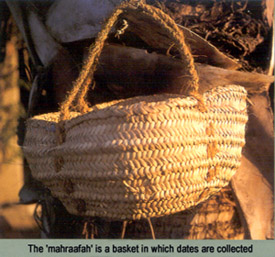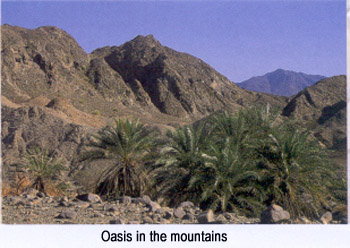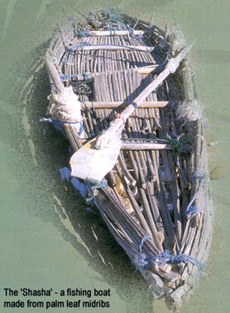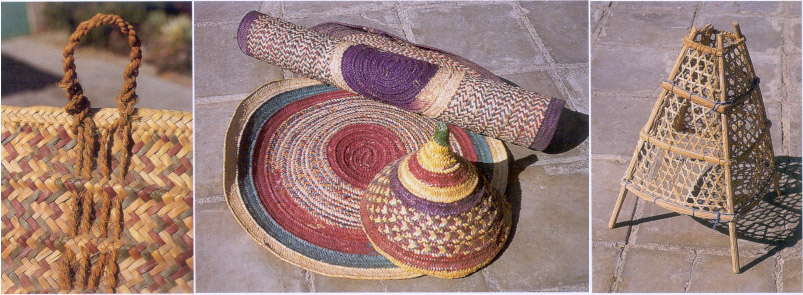|
The
date palm Phoenix dactylifera is so closely linked to life in the Middle East,
that its stylised image is found as logos
of many companies and enterprises and
even
on national flags.
There is evidence that the date palm was
already used as a food source as long
as
6,500 to 7,000 years ago as date stones
have been found in
archaeological
excavations. The earliest found so far
were two burnt date stones
from Dalma island in 1999 and have been dated by
radio-carbon tests to 4670
(+ 130)
BC and 5110 + (160 BC). Although it
cannot be determined if the stones
were
from wild or cultivated dates, they
certainly confirm that dates were
being
consumed at this early date.
The previous earliest evidence for
date palm
remains in the UAE was a date
palm imprint, excavated from Hili in Al
Ain, which
have been dated to around 3,000
BC.
 Certainly
the original nomadic tribes of the desert
Certainly
the original nomadic tribes of the desert
used dates as an easy-to-preserve source
of energy.
Lately, the existing date
plantations have been
greatly extended. In
1984 the Ministry of Agriculture
and Fisheries reported a total number of
1,850,000 date
palms in the country. By
mid-2000 there were 21 million
date palms,
occupying 53 % of the cultivated areas.
There are 120 local and imported varieties
of dates and
the UAE is home to 20% of the
world population of
date palms, producing (in 1999) 240.000 tons of dates!
The
date palm (“nakhl”) can grow up to 150
years
old. It starts bearing fruit when 4
to 5 years old and
can give full crops
between 15 and 75 years. Crops can vary
greatly and are usually around 400 lbs. a
year, but outstanding crops of
1000 lbs
have also been recorded!
One
top grade cluster, measuring up to 1 yard,
can bring Dhs. 1000! No wonder the Holy
Quran that mentions the date palm no less
than 29 times, calls it “the blessed
tree”.
The
date groves provide shade for a variety of
other crops, such as cotton, maize, citrus
fruits, pomegranates, alfalfa, vegetables
and wheat.
Mango trees are also often found
between the palm trees. Date palms need
quite a lot of water, but can be watered
once a week in the hot season, while once
every three weeks suffices during the
cooler months.
 Dates
are low in fat and high in carbohydrates,
fibre,
potassium and vitamins. They
can be dried on the stalks or spread out
on mats. Date products include syrup,
“dibs” (an indigenous honey made from
the juice), jam, chutney, vinegar and
fermented date juice. They can be pickled
or used in breads and cookies.
Dates
are low in fat and high in carbohydrates,
fibre,
potassium and vitamins. They
can be dried on the stalks or spread out
on mats. Date products include syrup,
“dibs” (an indigenous honey made from
the juice), jam, chutney, vinegar and
fermented date juice. They can be pickled
or used in breads and cookies.
Date cultivation is one of the most
complex and labour intensive agricultural
practices in the world. All the activities
necessary to produce a good crop of dates
necessitate climbing into the tree (often
up to 80 feet high!), usually in hot
temperatures.
Pollination
in this part of the world is still mainly
done by hand, by hanging strands of the
male flower upside down in the female
spadix, just as it opens. In other
countries such as the USA, where the
Spanish missionaries imported the palm
trees in the 18th century,
pollination is now done with machines.
Then follows the thinning of the bunches
and later the bagging of the fruit to
protect it from birds and bats. Finally
the harvesting can begin.
In
this region the most commonly found dates
are the yellow “khalas” , the red
“khumaizi” and the “lulu”.
King of the dates is the Moroccon “medjool”,
which is cured on the tree and contains
50% sugar and 2% each of protein, fat and
minerals.
Other
types of dates found in the UAE and Oman
are:
naghal,
manzaj, manhi, qashkantarah, farah (early
crops), barni, qashtabaq, handhal amd
nebselli (mid-summer crops) and khasab,
zabad, hilali, (late crops)
In
Saudi Arabia ruzeiz, kheneizy,
khalas and bukeira are grown in the
east, nebutseif, khudairi, sefiri, barhi,
sukkari and sullaj are grown in the
central region , while anbara, agwa, berni,
hilwa, holaya, safawim shalabi and
sukkaret are grown in the west. Damaged
dates can be used as animal feed, while
ground date pits are used as fertilizer
and to make charcoal.
The
greatest threat to the health of palm
trees is the Red Indian palm weevil (Pseudophilus
testaceus), a borer insect that can
quickly destroy entire groves. In the past
farmers used to hang a local herb called
“harmal” in the crown of the trees to
keep the pests away, but in latter days
crop dusting from planes has been more
popular. Another pest is the date bug Asarcopus palmarum, while mites and scale insects can cause quite a
lot of damage also. Of course ripe dates
are attractive to mice and other rodents
as well as birds and bats.
Propagation
of the palm tree can be sexual by way of
seeds and asexual by means of offshoots.
Nowadays palm seedlings are often
cultivated in laboratories, enabling the
production of thousands of new trees per
year.
During
the winter months the tree has to be
pruned. This is important because it
cleans the tree and allows new leaves to
grow. It reduces rodent and insect
infestation and facilitates harvesting. It
also improves crop quality by reducing
shade and bruising of the fruit. The
harvested leaves can be used to make many
products.
The
leaves are often dried, dyed and then
plaited into mats, trays or baskets. A
large conical “hat” is used locally as
a cover for food trays. The
wooden midribs are used for roofing, and
for making crates and boxes, and with the
dried leaves still attached a material,
called “areej” or “barasti”, is
used to make walls for huts or fencing. In
the past the midribs were also used to
make the “gargour”, the dome-shaped
fishing cage, which is now made of metal.
The hat-shaped muzzle that is used to
prevent camels from eating just before the
races used to be woven from palm fibres,
but for this item the leaves of the small
wild palm Nanorrhops
ritchieana were used.
The
palm trunks provide a sturdy building
material. The fibres from the sheaths of
the leaves are used to make rope and twine
or fishing nets, while heavy rope was made
from shredded date palm fruit stalks.
Shredded date leaflets were made into
two-strand cord of 75-to 80-cm. lengths.
An
interesting object made from palm tree
products could still be found on East
coast beaches during the nineteen
eighties, but nowadays it can only be
admired in musea or heritage centres.
The
“shasha” (pl. “shoosh”) or palm
reed boat was once the main fishing boat
of the region. The introduction of
fibreglass boats and the mechanisation of
the fishing industries have made the
“shasha” a thing of the past.
The
construction of a “shasha” could take
anywhere between a half to one full day,
provided the materials had been collected
and prepared beforehand. Ninety percent of
the material necessary for building these
boats was obtained from the date palm
tree. Some other material came from other
local trees such as the “sidr” (Zizyphuis spinachrsiti) or the “samr” (Acacia tortilis).

The
long fronds of the date palm were prepared
by removing the leaves and soaking the
stems. This makes them pliable so that
they could be tied together securely with
a rope, made from the fibre of the sheaths
of the palm leaves. The base layer of
stems was bound tightly and secured to a
frame made of the wood from the “sidr”
or “samr” tree.
This frame contained seven cross
beams along the base with corresponding
beams on either side of the boat. A large
block made from a section of the stem of a
date palm was attached to create buoyancy
(later this was replaced by styrofoam).
The
segments were bound together with date
palm rope. Another seven cross beams and
another layer of tightly bound stems were
placed on top. The sides of the boat were
also constructed with tightly bound date
palm stems. The “shasha” usually had
two oars, one located in the middle and
one in the back. The oars were made from
the wood of the “sidr” or “samr”
tree. The boat seated up to four people,
though there were some larger boats that
could carry five people.
 Its
primary function was as a fishing boat and
it was designed to travel for short
distances only. The section used for
buoyancy could absorb water and become
heavy, thus causing the boat to sink. The
boats usually travelled only about 15 kms,
going to and coming back from the fishing
grounds where the nets or fishing cages
were dropped.
Its
primary function was as a fishing boat and
it was designed to travel for short
distances only. The section used for
buoyancy could absorb water and become
heavy, thus causing the boat to sink. The
boats usually travelled only about 15 kms,
going to and coming back from the fishing
grounds where the nets or fishing cages
were dropped.
The
“shasha” was the main means of sea
transport on the East coast in the 19th
century. The lack of safe harbours and the
presence of heavy surf prohibited the use
of other types of boats. The “shasha”,
because of its lightness and flexibility,
could ride the heaviest surf.
Most “shoosh” were made in
Fujeirah and if a person from Dibba wanted
one, he would buy one in Fujeirah. Only a
very few older men are still alive that
can make this quaint fishing boat.
These
are just a few of the 360 uses of the date
palm that have been recorded.
In
a book on Oman by Wendell Philips it is
mentioned that a good Omani wife would be
able to give her husband a different dish
using dates every day of the year!
The
same book tells of a man who received a
letter one day. As it was already too dark
to read the letter, he manufactured a
small bowl from date paste, filled it with
melted ghee, inserted a wick, made from a
few strands of palm tree fibre, lit it and
read his letter. When he was finished. He
blew out the flame, removed the wick,
drank the oil and ate the lamp!
My
own favourite recipe is that for date bars
with a date shake
Chicken
stuffed with dates:
3 lbs chicken
1 onion finely chopped
1 oz. Butter
4 oz chopped dates
3 oz chopped dried apricots
3 oz seedless grapes
1 green apple
1 level teaspoon cinnamon
1 teaspoon brown sugar
freshly ground black pepper
to
cook: 1 oz. Butter and 1 tbsp. Lime juice.
Clean
and dry the chicken and set aside. Melt
the butter in the pan, add the onion and
cook until soft. Add the dates, apricots,
grapes and apple and cook over a low heat
for about two minutes. Stir in the
cinnamon and brown sugar spoon into the
cavity of the chicken and join the skin
together with a skewer. Rube the extra
butter over the chicken and drizzle with
lime juice.
Place
the chicken in a baking dish and bake for
about 1 hour 30 minutes. Allow to rest for
15 minutes before carving.
Serve with the pan juices, stuffing
and rice.
Date
shake: ¾ cup of dates (diced)
1
cup of milk
1 pint of vanilla ice cream
Put
the ingredients in a blender and process
for several minutes.

|
